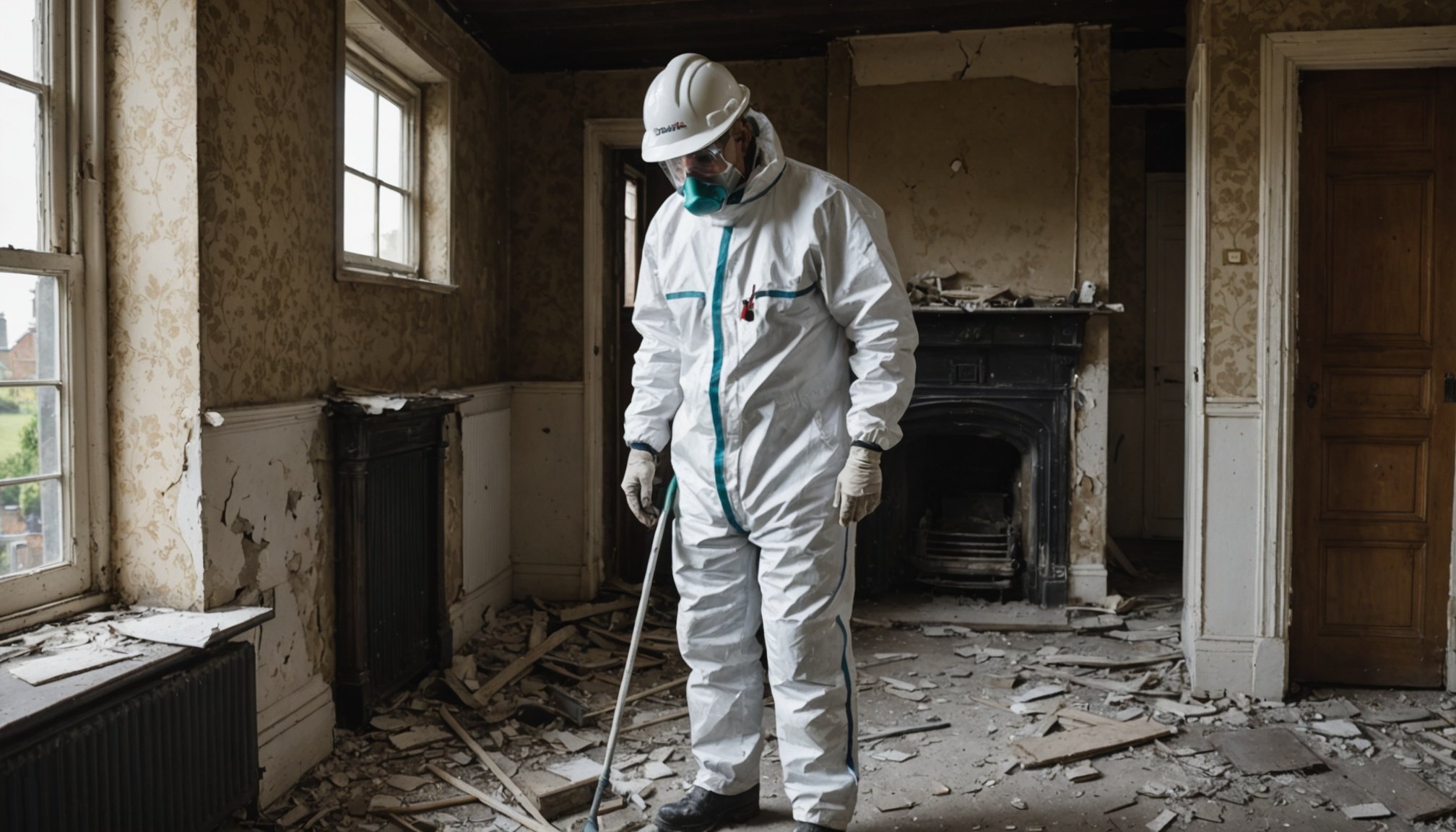Unveiling Asbestos Hazards: A Comprehensive Guide to Assessing and Mitigating Risks in Older UK Homes
As we navigate the complexities of home ownership, particularly in older properties, it’s crucial to address a silent but deadly threat that lurks in the shadows: asbestos. Despite its ban in the UK nearly 25 years ago, asbestos remains a significant health risk, especially for those living in or working on homes built before the 1980s. This guide aims to enlighten you on the dangers of asbestos, how to identify it, and most importantly, how to mitigate its risks.
Understanding Asbestos and Its Dangers
Asbestos is a mineral composed of thin fibers that were widely used in construction materials due to their insulating and fire-resistant properties. However, when these fibers are disturbed, they can be released into the air, posing a severe health risk to anyone who inhales them. The consequences of asbestos exposure are dire, leading to fatal diseases such as mesothelioma, lung cancer, and asbestosis[2].
Also to see : Assessing the Future Resilience of UK Real Estate Investments Amid Climate Change Challenges
Common Asbestos-Containing Materials (ACMs)
Asbestos can be found in various parts of older homes, often hidden in plain sight. Here are some common materials that may contain asbestos:
- Insulation: Asbestos was commonly used in attic insulation, particularly in the form of vermiculite.
- Floor Tiles: Vinyl floor tiles and the adhesive used to secure them can contain asbestos.
- Cement: Asbestos was mixed into cement to create durable and fire-resistant products, such as roofing and wall cladding.
- Pipes: Asbestos was used to insulate pipes, especially in older heating systems.
- Textured Ceilings: Popcorn ceilings, also known as textured ceilings, may contain asbestos.
Identifying Asbestos in Your Home
Identifying asbestos in your home is a critical step in managing its risks. Here are some key points to consider:
Also read : Unlocking Rental Income: Evaluating Opportunities in Up-and-Coming UK Property Markets
Visual Inspection
While it’s impossible to identify asbestos just by looking at it, you can suspect its presence based on the age of your home and the types of materials used. For example, if your home was built before the 1980s, it’s more likely to contain asbestos.
Professional Asbestos Surveys
For a definitive identification, it’s essential to hire a professional asbestos surveyor. These experts conduct thorough surveys to identify and assess the condition of ACMs in your home. Here’s what you can expect from an asbestos survey:
- Management Survey: This type of survey is designed to locate ACMs that could be disturbed during normal occupancy, including routine maintenance and repair.
- Refurbishment/Demolition Survey: This survey is more invasive and is conducted before any major renovation or demolition work. It aims to identify all ACMs that could be disturbed during the project.
Assessing the Risks of Asbestos Exposure
Understanding the risks associated with asbestos exposure is crucial for effective risk management.
Health Risks
Asbestos fibers can cause severe health issues when inhaled. Here are some of the key health risks:
- Mesothelioma: A rare form of cancer that affects the lining of the lungs, abdomen, or heart.
- Lung Cancer: Asbestos exposure increases the risk of developing lung cancer.
- Asbestosis: A chronic lung disease characterized by scarring of the lung tissue.
Risk Assessment
Conducting a risk assessment is vital to determine the potential risks posed by ACMs in your home. Here are some factors to consider:
- Condition of the Material: The condition of the ACM is a significant factor. Damaged or deteriorating materials are more likely to release fibers.
- Likelihood of Disturbance: Materials that are likely to be disturbed during maintenance, renovation, or daily activities pose a higher risk.
- Occupancy and Usage: The number of people exposed and the frequency of exposure also play a crucial role in risk assessment.
Mitigating Asbestos Risks in Your Home
Mitigating asbestos risks involves a combination of proper management, safety measures, and professional intervention.
Asbestos Management Plans
Developing an asbestos management plan is essential for homes containing ACMs. Here are some key components of such a plan:
- Identification and Assessment: Identify all ACMs and assess their condition and risk level.
- Monitoring: Regularly monitor the condition of ACMs to ensure they do not deteriorate.
- Training: Ensure that all occupants, especially those involved in maintenance and repairs, are trained on asbestos safety.
- Emergency Procedures: Establish clear emergency procedures in case of accidental disturbance of ACMs.
Safety Dos and Don’ts
Here are some critical safety dos and don’ts to keep in mind when dealing with potential asbestos-containing materials:
Dos:
- Avoid any contact with materials suspected to contain asbestos.
- Take every precaution not to damage materials that may contain asbestos.
- Talk to your home inspector or real estate agent about any known asbestos risks in your home.
- Only hire trained professionals for asbestos inspections, testing, repairs, or removal.
- If you plan to demolish a building, contact your local or state regulatory agency.
Don’ts:
- Do not attempt to remove or disturb ACMs yourself.
- Do not use power tools or vacuum cleaners that could release asbestos fibers into the air.
- Do not ignore the presence of ACMs; instead, manage them properly.
The Importance of Asbestos Training
Asbestos training is crucial for anyone who may encounter ACMs, whether it’s a homeowner, a tradesperson, or a maintenance worker.
Current Gaps in Asbestos Awareness
Recent research by High Speed Training highlighted alarming gaps in asbestos awareness among UK tradespeople. Despite the ban on asbestos nearly 25 years ago, many tradespeople underestimate the ongoing risk it poses. The study found that more than a third of tradespeople believed asbestos was no longer a serious risk, and nearly half felt their asbestos training was insufficient or outdated[1].
Advocacy for Mandatory Training
High Speed Training and its partners advocate for mandatory asbestos education for apprentices and college-level students to reduce future risks. Dr. Richard Anderson, Head of Learning and Development at High Speed Training, emphasized the need for better awareness: “Whilst asbestos has been banned in the UK since 1999, it is still present in many buildings in the UK… It can take as long as 30 years or more for symptoms of related diseases to appear, which really indicates the need for better awareness for tradespeople, their families, and the general public”[1].
Practical Insights and Actionable Advice
Here are some practical steps you can take to manage asbestos risks in your home:
Hire Licensed Asbestos Professionals
For any work involving ACMs, it is crucial to hire licensed asbestos professionals. These experts have the necessary training and equipment to handle asbestos safely.
Conduct Regular Asbestos Surveys
Regular surveys can help identify any changes in the condition of ACMs and ensure that they are managed properly.
Educate Yourself and Others
Educate all occupants of the home about the risks associated with asbestos and the importance of proper management. This includes understanding the dos and don’ts of handling materials that may contain asbestos.
Asbestos remains a significant health risk in older UK homes, despite its ban nearly 25 years ago. Understanding the dangers, identifying ACMs, assessing risks, and implementing proper management strategies are all crucial steps in mitigating these risks. By advocating for mandatory asbestos training, conducting regular surveys, and following safety guidelines, we can ensure a safer environment for everyone.
Table: Common Asbestos-Containing Materials and Their Risks
| Material | Common Locations | Risk Level | Precautions |
|---|---|---|---|
| Insulation | Attics, walls | High | Avoid disturbing; use professional removal services |
| Floor Tiles | Flooring | Medium | Avoid using power tools; seal edges to prevent fiber release |
| Cement | Roofing, external walls | High | Avoid drilling or cutting; use licensed asbestos professionals for removal |
| Pipes | Heating systems | Medium | Avoid disturbing insulation; use protective equipment when working near pipes |
| Textured Ceilings | Ceilings | Medium | Avoid using power tools; test for asbestos before any work |
Quotes and Insights
- “Asbestos removal regulations are in place to make sure that the risk of exposure to harmful fibres is limited and it’s imperative that guidelines are followed by a trained professional.” – Dr. Richard Anderson, High Speed Training[1].
- “The real danger comes when asbestos is disturbed. If it is left alone, it might not cause any harm. But when asbestos-containing materials are damaged, tiny fibres are released into the air.” – AJC Asbestos[4].
By reading this guide, you’ve taken the first step towards protecting yourself, your family, and others from the hidden dangers of asbestos. Remember, awareness and proper management are key to ensuring a safe and healthy living environment.











